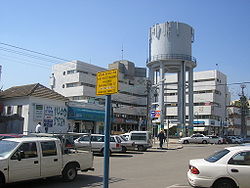Afula
Template:Infobox Israel municipality Afula (Template:Lang-he-n; Arabic: العفولة, al-ʻAfūlaḧ) is a city in the North District of Israel, often known as the "Capital of the Valley", referring to the Jezreel Valley. The city had a population of 39,200 at the end of 2007.[1]
History
Located in the lower Galilee region, Afula is roughly halfway between Jenin and Nazareth. It lies on the site of Biblical Ofel, the hometown of Gideon. It is mentioned in the Book of Kings (2 Kings 5, 24) in connection with Elisha and the disciple of Elijah, who lived in the vicinity.
In 1799, during Napoleon's Syrian campaign, the Battle of Mount Tabor was fought around the village of al-Fulah.
In 1909 or 1910, Yehoshua Hankin completed his first major purchase in the Jezreel Valley. He bought some 10,000 dunams (10 km²) of land in Al-Fuleh (now Afula), which became the home of Merchavia and Tel Adashim. This purchase also marked the start of bitter disputes between Arabs and Jews over the rights of tenant farmers who had been evicted, and regarding the employment of Jewish or Arab watchmen for the land.
The modern community of Afula was founded in 1925 by the American Zionist Commonwealth, after the completion of the purchase of the valley from the Sursuk family of Beirut. The nearby Arab village of Al-Fulah, which was founded by Saladin was disbanded by the turn of the century. At the time, the community was served by the Jezreel Valley railroad, which was abandoned during the War of Independence.
Because of Afula’s proximity to the West Bank, it has been a target for terrorists during the Oslo peace process and the second Intifada. On April 6, 1994, a car bombing carried out by Hamas in the center of Afula killed five people. Afula also was the target of a suicide attack on a bus May 5, 2002, in which one person died several people were injured at Afula’s central bus station. On May 19, 2003, Afula’s Amakim Mall was bombed, killing three and wounding 70. This attack was carried out by Palestinian Islamic Jihad and the Fatah movement’s Al-Aqsa Martyrs Brigades.
On July 17, 2006, Hezbollah fired Katyusha rockets at the Israeli city of Afula. Located in the Jezreel Valley, Afula is 31 miles south of the Lebanese border, and 28 miles southeast of Haifa. The bombing represents one the southernmost rocket attacks on Israel from Lebanon. Six people were treated for shock as a result of the bombing. On July 28, a rocket landed causing a fire. The Katyusha carried 100 kilograms of explosives.
The Afula central bus station is a hub for northern Israel, and the many falafel kiosks surrounding the bus station are very popular with hungry travelers.

Demographics
According to provisional data by the Israel Central Bureau of Statistics (CBS), by June 2008 the city had a total population of 39,300.[1] In 2001 the ethnic makeup of the city was 99.4% Jewish and other non-Arabs, without significant Arab population whilst there were 262 immigrant settlers. There were 18,500 males and 19,900 females. The population of the city was spread out with 34.3% 19 years of age or younger, 15.8% between 20 and 29, 17.5% between 30 and 44, 16.9% from 45 to 59, 4.0% from 60 to 64, and 11.5% 65 years of age or older. The population growth rate in 2001 was 0.9%. See Population groups in Israel.
Income
According to CBS, as of 2000, in the city there were 13,762 salaried workers and 887 are self-employed. The mean monthly wage in 2000 for a salaried worker in the city is ILS 4,723, a real change of 6.4% over the course of 2000. Salaried males have a mean monthly wage of ILS 5,913 (a real change of 8.6%) versus ILS 3,541 for females (a real change of 2.0%). The mean income for the self-employed is 6,477. There are 962 people who receive unemployment benefits and 3,938 people who receive an income guarantee.
Education
According to CBS, there are 24 schools and 8,688 students in the city. They are spread out as 16 elementary schools and 3,814 elementary school students, and 12 high schools and 4,874 high school students. 52.3% of 12th grade students were entitled to a matriculation certificate in 2001.
Twin cities
 Ingelheim am Rhein
Ingelheim am Rhein Providence, Rhode Island
Providence, Rhode Island Worcester, Massachusetts
Worcester, Massachusetts Stamford, Connecticut
Stamford, Connecticut Osnabrück
Osnabrück Santa Fe, Argentina
Santa Fe, Argentina
References
- ^ a b "Table 3 - Population of Localities Numbering Above 1,000 Residents and Other Rural Population" (PDF). Israel Central Bureau of Statistics. 2008-06-30. Retrieved 2008-10-18.



